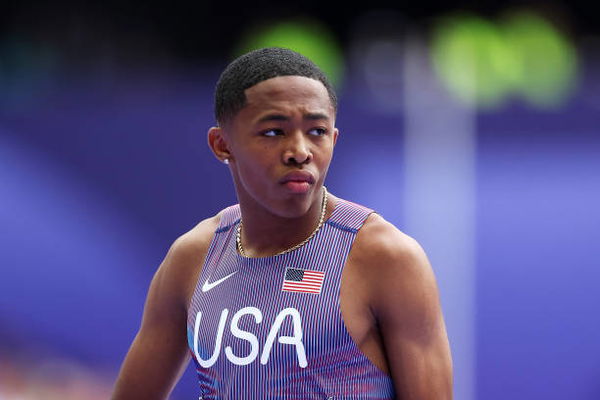
via Getty
Quincy Wilson during the Men’s 4 x 400m Relay Round 1 of the Olympic Games Paris 2024 at Stade de France. (Credit- Getty Images)

via Getty
Quincy Wilson during the Men’s 4 x 400m Relay Round 1 of the Olympic Games Paris 2024 at Stade de France. (Credit- Getty Images)
It was April 4, and all eyes at the Percy Beard Track in Gainesville, Florida, were glued to just one guy—Quincy Wilson. Coming off a sensational indoor season, the expectations for his outdoor season opener were also sky high from the 17-year-old track and field young gun. Coaches, fans, and critics alike anticipated that he would own the 400m at the Pepsi Florida Relays. But once the gun cracked, something did brew. But it wasn’t Quincy. Rather, it was the sprinter on lane 6 who stole the limelight. And the name? Tywan Cox.
For the first 300 meters, Cox brought heat. He didn’t just chase Quincy—he hunted him. Rodney Green would later describe it perfectly: “He ran like a hell of a 300.” But as they hit the home straight, the strain started to show. Around 320 meters in, Cox’s form wavered—his legs began to betray him. That’s when Quincy did what Quincy does best: dropped the hammer and glided across the line in 45.27 seconds. Tywan followed with a strong 46.29, but the damage was already done.
The next day, the heat was back—but this time, it wasn’t just the weather. It was personal. In the boys’ 4x400m relay, Quincy Wilson was set to anchor for Bullis High. Cool under pressure, always the closer. Tywan? He was there again. And this time, he wasn’t letting go. Meanwhile, the race unfolded with intensity, but everyone knew it would come down to the anchors. When the baton hit Quincy’s hand, it wasn’t just another leg of a race—it was a moment of reckoning.
ADVERTISEMENT
Article continues below this ad
But something was different. Quincy didn’t have the same snap in his stride. The elegant burst wasn’t quite there. Bullis crossed the line in 3:09.97, second to Miami Northwestern’s 3:08.74. Tywan had helped his team steal the show. Redemption was his. That’s where the Ready Set Go podcast, hosted by Olympic legend Justin Gatlin and sprint guru Rodney Green, steps in.
Rodney broke it down: “Quincy’s legs were kind of tied up from the sprinting… two rounds of the four-by-one. The split says 46. If he splits 46, that lets you know—those legs, kind of a little bit.” And he wasn’t wrong. Quincy had a full plate: two 4x100m rounds, a high-stakes 400m duel, and now the 4×4 anchor. Even superheroes get tired.
Meanwhile, Justin chimed in too: “If Tywan didn’t run his 400 the right way, then he got that energy to get that get back… He probably thought it was his day in the open four, and it didn’t turn out that way. So, he had to make it up in that four-by-four.” So, it wasn’t bitterness. It was a strategy. A teenager channeling frustration into fuel.

What’s your perspective on:
Is Quincy Wilson's unique form a strength or a hindrance in his quest for greatness?
Have an interesting take?
Well, both Gatlin and Green made it clear—there was nothing wrong with Quincy’s soreness. If anything, it proved his humanity. It showed that behind the stunning times and effortless finishes is a young athlete learning the grind, the pressure, and the price of being great. However, Justine had a few more impressive lines for Quincy in the past.
ADVERTISEMENT
Article continues below this ad
Quincy Wilson gets support from the Olympic champion
“Once he fixes that form, he’ll be lightning fast.” That was the call echoing through the timelines, quote tweets, and comment sections. To some fans, Quincy’s stride seemed a little unpolished, maybe a touch inefficient. The assumption? Sharpen the technique, and he’ll become unstoppable. But then came the mic drop—from none other than Justin Gatlin.
Back in March, while the debate kicked off, the 4-time world champion and Olympic gold medalist addressed the chatter in an episode of his Ready Set Go podcast. And he didn’t mince words. “I think that we always use a perfect form instead of saying efficient form.” According to Gatlin, the idea of some cookie-cutter “perfect” technique is a myth.
Every athlete brings something different to the track—limb length, joint mobility, natural rhythm—and what matters most is whether their movement works for them. “Efficient can mean something different, and it can work for that individual how their body is structured.” In short, Quincy’s form might not be textbook, but it’s his, and it’s currently producing elite results.
ADVERTISEMENT
Article continues below this ad
So why rush to fix something that’s already flying? Gatlin isn’t saying that Quincy’s stride is set in stone. “Doesn’t mean that it’s not going to change in the future…” The key? Timing. A good coach, Gatlin says, knows what to adjust now and what to tweak gradually—without throwing off the athlete’s rhythm or confidence. “You can’t just say, ‘Hey, change this and run like that guy, and you’re gonna get the same outcome.’ It doesn’t work like that.”
Because sometimes, form is more than biomechanics—it’s personality. It’s flair. It’s a runner’s fingerprint on the track. As Gatlin summed up with the calm of someone who’s seen it all, “Allow him to go out, find his rhythm. He’s running times that are superior. He’s winning races when it’s necessary and in their big moments.” Translation? Let the kid cook. Yes, polish will come. Yes, refinement is part of growth. But right now, Quincy Wilson is doing what needs to be done. He’s showing up. He’s showing off. And he’s doing it his way.
ADVERTISEMENT
ADVERTISEMENT
ADVERTISEMENT
ADVERTISEMENT


Is Quincy Wilson's unique form a strength or a hindrance in his quest for greatness?